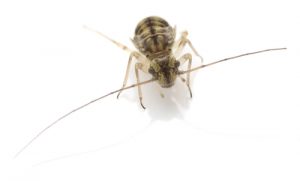Booklice Are Not Real Lice
By Chris Williams on October 18, 2011.
Q. What do booklice look like? Sometimes I feel like I’m being bitten in my home and I have lots of books. Do the lice live in the books?
A. First, booklice are not real lice and are not even remotely related to head lice or body lice. They do not bite people or any other animals. “Booklouse” is an unfortunate name because people get confused. I guess someone thought they looked like lice. At first glance the whitish, soft-bodied booklouse looks more like a termite worker, except it is much smaller at only 1/16 to 1/8 inch long. But it’s not related to termites either. The tiny booklouse (also called a psocid) is wingless and runs along surfaces in a jerky manner.
 Although they have no association with lice, booklice do have an association with books. Booklice feed on surface molds. They are usually pests in damp areas feeding on starchy paper products and book bindings, but they sometimes become stored product pests feeding on moldy grains. They can also be major (although temporary) pests in new construction where they feed on mold growing on damp materials. The booklouse doesn’t cause actual damage since it feeds mainly on surface molds, not on the underlying material itself. In foods, though, it does cause contamination simply by its presence.
Although they have no association with lice, booklice do have an association with books. Booklice feed on surface molds. They are usually pests in damp areas feeding on starchy paper products and book bindings, but they sometimes become stored product pests feeding on moldy grains. They can also be major (although temporary) pests in new construction where they feed on mold growing on damp materials. The booklouse doesn’t cause actual damage since it feeds mainly on surface molds, not on the underlying material itself. In foods, though, it does cause contamination simply by its presence.
Booklice can be found in damp, warm, dark, undisturbed areas where mold may be growing, such as the following:
· paper products, especially old books, newspapers, or cardboard stored in damp areas like garages and basements
· damp lumber, drywall, or plaster. Booklice are common pests in new construction materials that have not yet dried or seasoned.
· behind loose wallpaper in humid areas
· moldy cereals or grains, especially items on the back of the shelf or past the pull date
· moldy bird seed
· old furniture that may be stuffed with plant fibers like Spanish moss
· dried plant materials like hay, straw matting, or dried flower arrangements
· accumulations of dead insects like cluster flies or Asian lady beetles in attics or voids
The key to getting rid of booklice is to simply dry out the area out with ventilation, a dehumidifier, fans, or heat. If you lower the relative humidity to less than 60%, mold will not grow and booklice will not be able to survive. Discard any old or damp food products, including pet food or bird seed. A severe booklouse infestation might require an insecticide treatment by a pest control company.